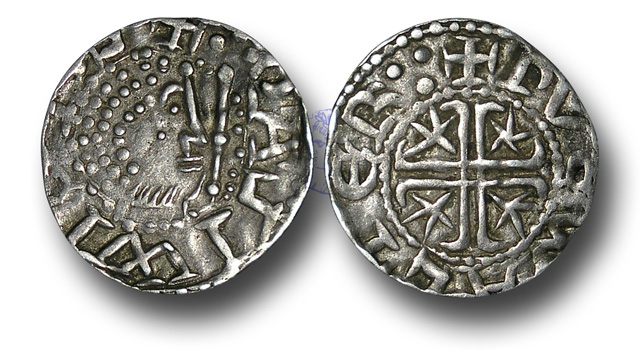Alexander was born at Roxburgh, the only son of Alexander II by his second wife Marie de Coucy. Alexander III was also the grandson of William the Lion. Alexander's father died on 8 July 1249 and he became king at the age of seven, inaugurated at Scone on 13 July 1249. The years of his minority featured an embittered struggle for the control of affairs between two rival parties, the one led by Walter Comyn, Earl of Menteith, the other by Alan Durward, Justiciar of Scotia. The former dominated the early years of Alexander's reign.
 |
| Alexander III coin |
At the marriage of Alexander to Margaret of England in 1251, Henry III of England seized the opportunity to demand from his son-in-law homage for the Scottish kingdom, but Alexander did not comply.
In 1255 an interview between the English and Scottish kings at Kelso led to Menteith and his party losing to Durward's party. But though disgraced, they still retained great influence, and two years later, seizing the person of the king, they compelled their rivals to consent to the erection of a regency representative of both parties.
On attaining his majority at the age of 21 in 1262, Alexander declared his intention of resuming the projects on the Western Isles which the death of his father thirteen years before had cut short. He laid a formal claim before the Norwegian king Haakon iv. Haakon rejected the claim, and in the following year responded with a formidable invasion. Sailing around the west coast of Scotland he halted off the Isle of Arran, and negotiations commenced. Alexander artfully prolonged the talks until the autumn storms should begin.
 |
| Alexander III coin |
 |
| By Alexander's side is Maol Choluim II, Earl of Fife holding the sword |
Margaret (28 February 1261 – 9 April 1283), who married King Eric II of Norway. Alexander, Prince of Scotland (21 January 1264 Jedburgh – 28 January 1284 Lindores Abbey); buried in Dunfermline Abbey. David (20 March 1272 – June 1281 Stirling Castle); buried in Dunfermline Abbey
According to the Lanercost Chronicle, Alexander did not spend his decade as a widower alone: "he used never to forbear on account of season nor storm, nor for perils of flood or rocky cliffs, but would visit none too creditably nuns or matrons, virgins or widows as the fancy seized him, sometimes in disguise."
Towards the end of Alexander's reign, the death of all three of his children within a few years made the question of the succession one of pressing importance. In 1284 he induced the Estates to recognise as his heir-presumptive his grand-daughter Margaret, the "Maid of Norway". The need for a male heir led him to contract a second marriage to Yolande de Dreux on 1 November 1285.
 |
| Maol Choluim II & Alexander III |
He was advised by them not to make the journey to Fife because of weather conditions, but he travelled anyway. Alexander became separated from his guides and it is assumed that in the dark his horse lost its footing. The 44-year-old king was found dead on the shore the following morning with a broken neck. Some texts have said that he fell off a cliff. Although there is no cliff at the site where his body was found, there is a very steep rocky embankment, which "would have been fatal in the dark." After Alexander's death, his strong realm was plunged into a period of darkness that would eventually lead to war with England. He was buried in Dunfermline Abbey.
 |
| Alexander III |
As Alexander left no surviving children, the heir to the throne was his unborn child by Queen Yolande. When Yolande's pregnancy ended, probably with a miscarriage, Alexander's seven-year-old granddaughter Margaret, Maid of Norway, became the heir. Margaret died, still uncrowned, on her way to Scotland in 1290.
The inauguration of John Balliol as king on 30 November 1292 ended the six years of the Guardians of Scotland governing the land. The death of Alexander and the subsequent period of instability in Scotland was lamented in an early Scots poem recorded by Andrew of Wyntoun in his Orygynale Cronykil of Scotland.
Quhen Alysandyr oure kyng was dede,
That Scotland led in luve and le,
Away was sons of ale and brede,
Of wyne and wax of gamyn and gle.
Oure gold was changed into lede,
Cryst, born into vyrgynyte,
Succoure Scotland and remede,
That stat is in perplexyte.














